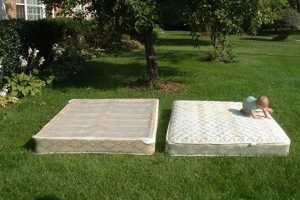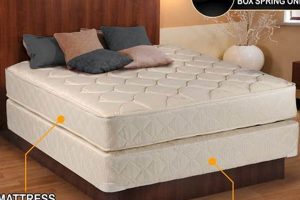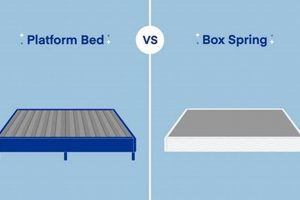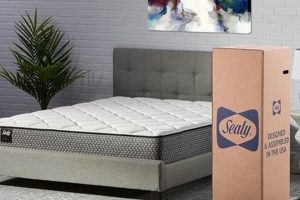A bed designed for a single sleeper, compressed and packaged for convenient shipping, offers a streamlined purchasing and delivery experience. This product caters to individuals seeking a space-saving and easily transportable bedding solution. Examples include memory foam, innerspring, and hybrid designs compressed and rolled for efficient handling.
The product’s significance lies in its ease of access and affordability. The simplified delivery process reduces transportation costs and logistical complexities, often resulting in lower prices for consumers. Historically, this packaging method has revolutionized the mattress industry, allowing direct-to-consumer brands to flourish and offering customers a greater range of choices.
The following sections will delve into the construction materials, size considerations, support systems, and factors influencing the purchasing decision related to such sleep solutions. This article aims to provide a comprehensive understanding of what to look for when selecting one that meets individual needs and preferences.
Selecting a Compact Single Bedding Solution
Choosing the appropriate compressed single bed requires careful consideration of several factors. Understanding these key aspects ensures a purchase that aligns with individual sleep preferences and budgetary constraints.
Tip 1: Research Material Composition: Prioritize mattresses utilizing CertiPUR-US certified foams to minimize off-gassing and ensure material safety. Examine the density and type of foam (e.g., memory foam, latex) to determine its firmness and suitability for preferred sleep positions.
Tip 2: Evaluate Support System: Inspect the type of support core, such as innerspring coils or high-density foam. Innerspring mattresses offer bounce and airflow, while foam cores provide motion isolation and pressure relief. Consider the coil gauge for innerspring models; lower gauges typically indicate firmer support.
Tip 3: Analyze Edge Support: Assess the quality of edge support, particularly for those who sleep near the edge of the bed. Reinforced edges prevent sagging and maximize usable sleeping surface.
Tip 4: Review Firmness Level: Determine the ideal firmness level based on sleeping position and personal preferences. Side sleepers often benefit from softer mattresses, while back and stomach sleepers typically prefer firmer options.
Tip 5: Investigate Trial Period and Return Policy: Choose a manufacturer offering a generous trial period and a straightforward return policy. This allows ample time to evaluate the mattress at home and return it if it proves unsatisfactory.
Tip 6: Compare Pricing and Value: Scrutinize pricing across different brands and models. Consider the overall value proposition, taking into account material quality, construction, warranty, and customer reviews.
Tip 7: Consider Height and Foundation Compatibility: Verify that the chosen mattress height is compatible with existing bed frames or intended foundations. Adjustments may be necessary to ensure proper support and aesthetic alignment.
By adhering to these guidelines, a well-informed decision can be made, resulting in a comfortable and supportive sleep environment. The following sections will provide a more in-depth analysis of specific mattress features and considerations to ensure a sound investment.
1. Dimensions
Dimensional considerations are fundamental when selecting a compressed single bed. Precise measurements ensure compatibility with existing bed frames and intended sleeping spaces. Deviation from standard dimensions can lead to instability, discomfort, and inefficient use of space.
- Standard Size Compliance
The industry standard for a twin-size mattress is 38 inches wide by 75 inches long. Adherence to these dimensions is crucial to guarantee proper fit within designated bed frames. Non-standard sizes necessitate custom frames or may result in overhang, compromising support and structural integrity.
- Height Considerations
Mattress height varies significantly, ranging from slim profiles (6-8 inches) to thicker models (12-14 inches). The appropriate height should be considered in conjunction with the bed frame and user height. A taller mattress on a high bed frame may create difficulty getting in and out of bed, especially for individuals with mobility limitations.
- Space Optimization
In smaller living spaces, the compact nature of the twin size is advantageous. Its dimensions allow for efficient use of floor space, particularly in bedrooms designed for single occupants. Accurate measurement of the available area is essential to prevent overcrowding and ensure freedom of movement.
- Weight Capacity
While technically not a dimension in the traditional sense, weight capacity is intrinsically linked to the mattress’s physical properties. It dictates the maximum weight the mattress can safely support without compromising structural integrity or comfort. Exceeding the specified weight limit can lead to premature wear, sagging, and reduced support.
In summary, understanding the dimensional characteristics of a compressed single bed is paramount to ensure compatibility, comfort, and longevity. Accurate measurements and careful consideration of height, space optimization, and weight capacity are essential for making an informed purchasing decision. These elements collectively contribute to a sleep environment that is both functional and supportive.
2. Comfort
The subjective experience of comfort is a critical determinant of satisfaction with a compressed single bed. The selected model must align with individual preferences regarding firmness, support, and temperature regulation to ensure restful sleep.
- Material Composition and Feel
The constituent materials significantly influence the surface feel and overall comfort. Memory foam conforms to the body’s contours, providing pressure relief, while latex offers a more resilient and responsive feel. Hybrid mattresses combine these materials with innerspring coils to achieve a balance of support and comfort. The choice depends on individual preferences for firmness and responsiveness.
- Firmness Level and Sleep Position
The optimal firmness level is directly correlated to the user’s primary sleep position. Side sleepers generally benefit from softer mattresses that allow the shoulders and hips to sink in, maintaining spinal alignment. Back sleepers often prefer medium-firm mattresses that provide adequate support without excessive sinking. Stomach sleepers typically require firmer mattresses to prevent excessive spinal curvature.
- Temperature Regulation and Breathability
Mattress materials vary in their ability to regulate temperature. Memory foam can trap heat, leading to discomfort for some individuals. Latex and innerspring mattresses tend to offer better breathability and temperature regulation. Gel-infused foams and ventilated designs can further enhance cooling properties, particularly important for those who sleep hot.
- Motion Isolation and Partner Disturbance
Although twin mattresses are typically used by single sleepers, motion isolation remains relevant. High motion isolation minimizes the transfer of movement across the mattress surface. This is beneficial if the sleeper tends to move frequently during the night. The ability of a twin mattress to absorb movement can still be a factor in a small room, minimizing vibrations that might disturb sleep.
Ultimately, the comfort of a compressed single bed is a multifaceted consideration shaped by material composition, firmness level, temperature regulation, and motion isolation. A thorough evaluation of these factors, aligned with individual preferences and sleeping habits, is essential for selecting a mattress that promotes restorative sleep. A trial period, if offered, enables confirmation of comfort claims in a home setting.
3. Support
The term “support,” in the context of a compressed single bed, refers to the mattress’s ability to maintain proper spinal alignment and distribute body weight evenly. A lack of adequate support can lead to discomfort, pain, and disrupted sleep patterns. The core functionality of a mattress is to provide a stable and anatomically correct sleeping surface, and this is especially vital for a sleeping product intended for individual use. For instance, a compressed single bed with insufficient support may cause back pain for a heavier individual, negating the convenience and space-saving benefits of its design. A properly supportive mattress prevents excessive sinking or sagging, ensuring the spine remains in a neutral position throughout the night.
Several factors contribute to the support offered by a compressed single bed. The type of support core, whether innerspring coils or high-density foam, plays a crucial role. Innerspring mattresses offer a more traditional support structure, with coils distributing weight and providing bounce. Foam cores, on the other hand, offer contouring and pressure relief. The density of the foam is a key indicator of its supportive capabilities, with higher densities generally offering more robust support. For example, high-density memory foam can effectively cradle the body, minimizing pressure points and promoting proper spinal alignment. Another example is hybrid models that combine coils and foam to maximize support.
In conclusion, “support” is an indispensable aspect of a compressed single bed, influencing comfort, spinal health, and overall sleep quality. Understanding the materials and construction techniques that contribute to support allows for informed purchasing decisions. Selecting a compressed single bed with adequate support ensures the user reaps the benefits of its convenience and space-saving design without compromising their well-being. The appropriate level of firmness is critical for proper support, and consulting with sleep specialists is a suggested path to optimize support for certain specific medical conditions, thus improving sleep health.
4. Materials
The composition of a compressed single bed directly dictates its comfort, durability, and overall performance. Material selection has a cascading effect, influencing factors from temperature regulation to spinal support. For example, a compressed single bed incorporating low-density foam may exhibit premature sagging and reduced support, rendering it unsuitable for prolonged use. Conversely, a model utilizing high-density memory foam or latex could provide enhanced contouring and pressure relief, promoting a more restful sleep experience. The practical significance of understanding material properties lies in the ability to make informed purchasing decisions, optimizing both value and long-term satisfaction. The difference between a low-cost polyurethane and a high cost latex and coil hybrid is huge, and can significantly impact lifespan of product, comfort, and sleep health.
The practical applications of material knowledge extend beyond mere comfort. The hypoallergenic properties of certain materials, such as latex and bamboo-derived fabrics, are crucial for individuals with allergies or sensitivities. Similarly, the breathability of materials like open-cell foam and cotton affects temperature regulation, preventing overheating during sleep. The longevity of a compressed single bed is also intrinsically linked to the quality of its materials. Reinforced edges, durable coil systems, and high-density foams contribute to resistance to wear and tear, extending the lifespan of the product. Furthermore, it’s key that any foam product used in the mattress, especially if imported, should have CertiPUR-US certification.
In summary, the relationship between materials and a compressed single bed is multifaceted, encompassing comfort, support, durability, and health considerations. The informed selection of materials is pivotal to ensuring a sleep environment that is both comfortable and conducive to well-being. Challenges arise in navigating the myriad of material options and marketing claims, emphasizing the need for thorough research and critical evaluation. The focus on materials ultimately connects to the broader theme of optimizing sleep quality through informed consumer choices, and can have long term health implications. Quality material means quality sleep.
5. Delivery
Delivery represents a pivotal aspect of the compressed single bedding product category, directly impacting consumer convenience and the overall purchasing experience. The compressed and packaged format enables efficient shipping methods that are not feasible for traditional mattresses. This transformative delivery system has reshaped the industry, fostering the rise of direct-to-consumer brands and altering consumer expectations.
- Compression Technology and Packaging
The compression process involves compacting the mattress using specialized machinery and encasing it in durable, airtight packaging. This significantly reduces the volume and weight of the product, facilitating cost-effective shipping through standard parcel carriers. Examples include mattresses rolled and encased in plastic wrapping, then placed within a cardboard box. This innovation makes delivery to apartments and homes with narrow doorways significantly more manageable.
- Direct-to-Consumer Model and Reduced Costs
The compressed format enables direct shipment from manufacturers to consumers, bypassing traditional retail channels. This eliminates intermediary markups, reducing overall costs. Direct-to-consumer brands often offer free shipping as a competitive advantage, further enhancing affordability and convenience.
- Convenience and Accessibility
The ability to have a mattress delivered directly to one’s doorstep eliminates the need for scheduling delivery appointments with specialized furniture carriers. This offers consumers greater flexibility and control over the delivery process. Consumers in remote areas, where access to traditional mattress retailers may be limited, also benefit significantly.
- Potential Challenges and Considerations
While the compression process generally does not compromise mattress quality, it is essential to allow sufficient time for the mattress to fully expand upon unpacking. The packaging process can result in initial off-gassing, which typically dissipates within a few days. Reputable manufacturers utilize CertiPUR-US certified foams to minimize these concerns.
The delivery model is inseparable from the appeal and marketability of the compressed single bed. It represents a convergence of technological innovation, streamlined logistics, and consumer-centric design. The convenience and cost savings associated with this delivery approach have established it as a core feature of the mattress industry, solidifying its role in shaping consumer expectations and preferences.
Frequently Asked Questions
The following questions address common inquiries and concerns regarding the purchase and use of a twin mattress compressed and packaged for shipping. Clarity on these points assists in informed decision-making.
Question 1: Does compressing a twin mattress in a box compromise its quality and long-term durability?
The compression process, when executed correctly with appropriate technology, does not inherently compromise the quality or long-term durability. Reputable manufacturers employ high-density materials and robust construction techniques to ensure the mattress recovers its original shape and performance capabilities after expansion.
Question 2: How long should be allowed for a twin mattress in a box to fully expand after unboxing?
The majority of compressed single beds require between 24 and 72 hours to fully expand. Certain models may achieve near-complete expansion within a few hours, but allowing the full recommended timeframe ensures optimal performance and prevents potential sagging or unevenness.
Question 3: Is there a risk of off-gassing with a twin mattress in a box, and what measures mitigate this?
A degree of off-gassing is a potential concern, particularly with mattresses incorporating polyurethane foams. Selecting products with CertiPUR-US certification ensures that the foams have been independently tested for harmful chemicals and volatile organic compounds (VOCs), minimizing the risk of unpleasant odors and potential health effects.
Question 4: Are twin mattresses in boxes suitable for all types of bed frames and foundations?
Twin mattresses in boxes are generally compatible with most standard bed frames and foundations, including platform beds, slatted frames, and adjustable bases. Verifying the compatibility of the mattress height and weight with the specific frame or foundation is recommended to ensure optimal support and stability.
Question 5: What recourse is available if the delivered twin mattress in a box fails to meet expectations or exhibits defects?
Most manufacturers offer trial periods and return policies allowing customers to evaluate the mattress within a specific timeframe. Familiarization with the terms and conditions of the warranty and return policy prior to purchase ensures recourse in case of defects or dissatisfaction.
Question 6: How does the cost of a twin mattress in a box compare to that of a traditional twin mattress purchased in a store?
Twin mattresses in boxes often offer a more competitive price point due to the direct-to-consumer business model, eliminating retail markups. Comparing the overall value proposition, including material quality, warranty, and return policy, is crucial in determining the most cost-effective option.
Understanding these essential aspects of compressed single bedding helps in making the best possible purchasing decision. The ultimate decision will depend on individual requirements.
The following will cover cleaning & care considerations.
Conclusion
This exploration has provided a comprehensive overview of the twin mattress in box product category, encompassing dimensions, comfort, support, materials, delivery, and frequently asked questions. The analysis underscores the significance of material composition, support systems, and delivery logistics in determining product value and consumer satisfaction. Attention to detail regarding firmness, certifications, and weight capacity further enhances purchasing decisions.
Ultimately, selecting a twin mattress in box requires informed deliberation. Continued advancements in compression technology and material science will likely refine product offerings and consumer experiences. Diligent research and a discerning approach are vital for securing a sleep solution aligned with individual needs and preferences, solidifying long term sleep health.




![Best Queen Bed Mattress with Box Spring Set [Deals] Organic & Natural Mattress Buyer’s Guide: Non-Toxic Sleep Solutions Best Queen Bed Mattress with Box Spring Set [Deals] | Organic & Natural Mattress Buyer’s Guide: Non-Toxic Sleep Solutions](https://mattressworldpa.com/wp-content/uploads/2025/07/th-3379-300x200.jpg)


